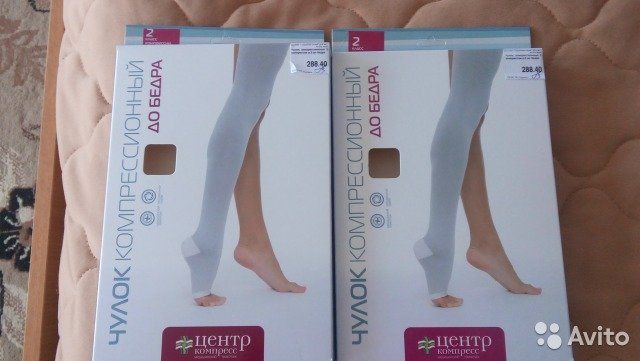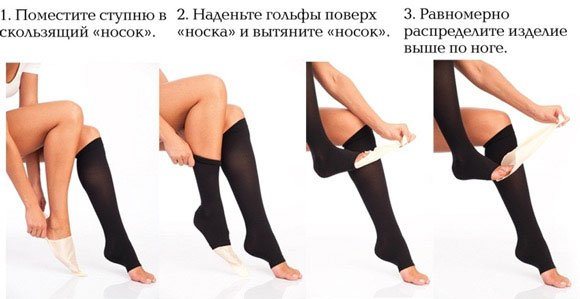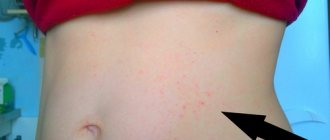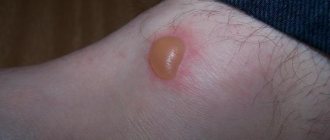Compression stockings during pregnancy are the key to health
Varicose veins are a disease that can appear at any age. It poses the greatest danger to pregnant women. If the expectant mother has a predisposition to varicose veins, and also has spider veins or spider veins, swollen legs, or pain in the calf muscles, then this is a direct indication for wearing compression stockings during pregnancy.
Compression stockings deserve special attention among pregnant women, as they do not squeeze the stomach and do not interfere with going to the toilet, which is especially important in the last stages of pregnancy. Compression stockings are divided into two types: orthopedic (therapeutic) and preventive
Compression stockings are divided into two types: orthopedic (therapeutic) and preventive.
- Prophylactic stockings with compression degree up to 18 mmHg. sold without a prescription. They are almost no different from ordinary nylon ones. Every woman can wear them to prevent vascular diseases without a doctor’s recommendation. It is especially necessary to wear preventive stockings for women at risk.
- Therapeutic stockings are prescribed by a phlebologist, who also determines the required degree of compression. You can purchase them in specialized stores.
Thereby:
- blood circulates more actively;
- veins do not dilate;
- there is a better supply of oxygen;
- the risk of seizures and blood clots is reduced;
- Extracellular fluid is better absorbed, which reduces swelling.
According to the degree of compression, therapeutic stockings are divided into several classes:
- Class 1: compression (pressure on the legs) up to 23 mm Hg. Indications for use are: spider veins, pain, enlarged veins.
- Class 2: compression up to 33 mmHg. Such underwear is prescribed for thrombophlebitis or varicose veins.
- Class 3: compression up to 45 mmHg. The indication for wearing underwear of this class is severe venous insufficiency.
- Class 4: compression above 50 mmHg. Indications: severe vascular damage, impaired lymph flow and, as a result, very severe swelling.
You should not wear compression garments if you have the following conditions:
- allergies, manifested by rashes and eczema;
- diabetic wounds and other skin lesions;
- bleeding;
- heart and lung diseases;
- chronic vascular diseases, for example, atherosclerosis.
In order to have a positive effect from wearing compression hosiery, and also for the product to last longer, you must follow some rules:
- Therapeutic knitwear must be selected according to size.
- It is necessary to wear orthopedic stockings from the very beginning of pregnancy; preventive stockings can be worn from the second trimester.
- You need to put it on in the morning, without getting out of bed. For convenience, you can use a special device - a butler. You need to take off your underwear before going to bed. If the products are class 3-4, then you can wear them less - the doctor will tell you about this.
- Wash the product by hand in warm water, do not twist it, dry it flat to avoid deformation of the threads.
- Handle the product with care, as any damage may disrupt pressure distribution.
The therapeutic effect depends on the correct choice of knitwear
Here it is important to choose a quality product that will last at least 9–10 months. Once the brand and model have been chosen, all that remains is to decide on the size.
To correctly determine the size, you need to take measurements using a centimeter tape: the circumference of the hip, the lower leg at the top and bottom, the length of the foot and leg. It is better to take measurements in the morning, before your legs swell.
If the size is chosen correctly, the stockings will not roll down. At first, you may feel discomfort from unusual compression.
Latest information: Varicose veins of the lower extremities. Clinical protocol for varicose veins. Varicose veins of the lower extremities
Medicinal products are presented by various manufacturers to suit every taste and budget. The most popular manufacturers of therapeutic knitwear: Medi (Germany), Venoteks (USA) and Orto (Russia). They have long established themselves in the market as creators of high-quality products that have excellent performance properties.
Knitwear is available in various models. There are both budget and expensive products. What they all have in common is the quality of their workmanship.
The service life of such products is 9-10 months.
Compression stockings are an excellent way to prevent or treat varicose veins during pregnancy. Prophylactic underwear can be worn without prescription, and therapeutic underwear is selected by a doctor
It is important to take into account contraindications and select the correct size and degree of compression. For effective results, underwear is worn from the beginning of pregnancy, removed only at night
Classification of therapeutic knitwear
Based on each specific case, a specific type and class of knitwear is selected.
Depending on the degree of compression effect, the following classes of knitted products are distinguished:
- No. 1 – The compression effect reaches no more than 23 mm. rt. Art. Such knitwear is recommended for use for minor swelling, the first signs of the appearance of spider veins.
- No. 2 – Pressure distribution does not exceed 33 mm. rt. Art. Compression stockings are recommended to be worn if varicose veins and thrombophlebitis develop.
- No. 3 – Compression pressure approximately 45 mm. rt. Art., specialized underwear is prescribed by doctors for complex degrees of development of venous insufficiency.
- No. 4 – The effect is 50 mm. rt. Art. This class of compression garments allows you to eliminate severe swelling and normalize lymph flow.
The main types of compression hosiery include knee socks, stockings, and tights.
The most popular products during pregnancy are therapeutic stockings. They do not cause any discomfort and have an attractive appearance. Due to the peculiarities of tailoring, compression stockings during pregnancy do not put pressure on the tummy for edema and do not cause any harm to the fetus.
To prevent edema stockings for pregnant women from slipping down the legs and interfering with blood circulation, special silicone inserts have been developed.
Therapeutic effect of compression garments
If you feel that your legs are completely stiff or you have difficulty putting on shoes in the evening, then you should seriously think about buying compression garments. Pregnancy is a testing time for the female body. Rapidly gaining weight creates a lot of pressure on the legs, added to this are altered hormonal levels and increased blood volume - all these reasons provoke the appearance of dilated veins, swelling and pain. So, let’s find out why compression stockings are needed:
- protect veins from expansion;
- uniform pressure on the legs promotes normal blood circulation;
- vessels, veins and tissues are saturated with oxygen;
- prevention of thrombosis;
- swelling is eliminated.
It is recommended that all women, without exception, use compression stockings for childbirth to prevent the formation of blood clots, which can occur as a result of excessive pressure exerted on the lower extremities of the woman in labor. For safety and health, doctors recommend wearing preventive underwear throughout pregnancy. According to indications, women in labor should wear supportive underwear for a certain time after childbirth.
Why do pregnant women need compression stockings?
During pregnancy, a woman's body undergoes profound hormonal changes. The hormone progesterone, which relaxes the smooth muscle muscles of the uterus, simultaneously relaxes the smooth muscle muscles of the venous walls. Veins lose tone and stretch . Because of this, blood stagnates in the legs and venous edema occurs. Under the influence of the hormone relaxin, the pelvic ligaments relax. This is necessary to prepare for childbirth, but along with the pelvic ligaments, the foot ligaments also relax. Temporary flat feet in pregnant women occur, causing pain in the legs when walking.
The body weight of pregnant women increases by 7-15 kg. This overloads the legs, causing lactic acid to build up in the muscles (like after an intense workout at the gym). This increases leg discomfort during pregnancy. Compression stockings for pregnant women "Intex" support the vascular walls of veins weakened by progesterone, preventing them from stretching. This avoids the formation of edema and reduces the risk of developing varicose veins during pregnancy .
Intex medical stockings apply distributed pressure to the legs, improving blood supply to the legs and accelerating the removal of lactic acid from the muscles. Reducing the load on the muscles eases the condition of the legs and makes it easier to tolerate temporary flat feet.
Device for putting on compression hosiery and its cost
Despite the apparent simplicity of the process of putting on medical jersey, it is very difficult to do. Especially when it comes to stockings with compression classes 3 and 4. When buying compression underwear of the wrong size, you doom yourself to additional pain when putting it on and wearing it, and also minimize the therapeutic effect. And in some cases, putting too much pressure on your feet can be harmful.
Each manufacturer has its own size chart, so when choosing medical items, it is best to use the help of a consultant. Many girls believe that if they apply moisturizer or oil to their feet, it will be easier to put on the product. This is fundamentally wrong. Compression fabric glides best over completely dry skin. Skin oily from cream or oil, on the contrary, will complicate this process.
The only thing that can make the task a little easier is medical gloves. To make putting on medical items easier, we developed a special spray and a device for putting on compression hosiery.
Sprays for easy putting on and comfortable wearing of compression hosiery not only help you put it on, but also take care of your legs, moisturizing the skin, having a venotonic effect, and they also help relieve swelling and minimize pain.
Before use, the bottle must be shaken to ensure uniformity of the emulsion contained in it. The spray is sprayed onto the back surface of the product from a distance of 25-30 centimeters. This must be done every time before using medical knitwear.
To significantly simplify the process and reduce the time of putting on medical underwear, you can use a special device for putting on compression hosiery. This device is recommended for use by elderly people, overweight patients, bedridden patients and pregnant women, that is, those who cannot bend over on their own.
Latest information: Varifort pillow for varicose veins
There are many different models of butlers:
- The standard product is suitable for putting on any type of compression garment.
- Big is suitable for putting on large-sized medical lingerie. Its distinctive feature is the elongated handles.
- Butler Long is most convenient for size 4 underwear, and the length of its handles allows you to avoid bending over while dressing.
- In the Vario modification it is possible to adjust the length of the handles.
- The Travel model is designed for travel and travel. It folds easily and fits into a small handbag.
- A special device for tights allows you to wear compression tights on two legs at once. The length of the handles allows you to do this without bending over.
- The hospital device is designed for bedridden patients.
- Reha has a flatter part, more suitable for people with limited mobility.
All battlers are visually similar to each other, they are a system of arcs with a stable base. They are made of metal (less often plastic), carefully cleaned and coated with paint. The preparatory stage is to place the product on the element of the device that imitates a leg
It is important to ensure that there is safe stretching in the area of maximum compression. This is necessary to maintain the integrity of the fabric fibers
The toe and heel should hang down, and the rest of the part should be turned inside out. The entire product is distributed on the arc like a small accordion. Then you need to insert your leg, straighten your toe and place your foot on the floor. After this, with smooth movements we pull the handles up to the desired height. The elastic band should be located above the affected vein. Using the device, tights can only be worn up to the thigh. Next you will have to work with your hands.
The price of such an assistant depends on the chosen model and manufacturer. The cost of a standard product varies from 1200 to 3000 rubles. Big and Long models cost around 5,000 rubles. The price of the Butler in the Travel modification reaches 8,300 rubles. For a device specially designed for tights, you will have to pay approximately 7,000 rubles.
The range of prices for hospital structures is the largest and ranges from 1800 to 7500 rubles. Butler, adapted for people with limited mobility, costs approximately 7,300 rubles.
Product care
In order for compression stockings, tights or knee socks to last a long time, they need to be looked after and cared for. How to do it? – Gentle daily wash in warm water using baby soap. This remedy was chosen due to the minimal risk of allergies, which is important during pregnancy and childbirth.
If the stockings are torn, you should not wear them, but rather consult a doctor and get advice. Most likely, the therapeutic or preventive effect of such underwear will be reduced and the doctor will recommend buying new ones.
Summarizing the above
Compression garments should be worn in the following cases:
- for preventive purposes during the entire period of pregnancy;
- during caesarean section;
- when using epidural (peridural) anesthesia;
- long bed rest.
Thanks to compression garments, you will keep your legs healthy and beautiful and will be able to wear short skirts and dresses that reveal well-groomed and slender legs.
How to wear compression stockings during pregnancy, advice from doctors
To receive recommendations for wearing compression stockings, a pregnant woman must inform her gynecologist about swelling of the legs, pain in the legs at the end of the working day, even if there is a mark left on the leg from an elastic band or spider veins have appeared on the thighs, and the veins have begun to protrude under knees.
Latest information: Tip 1 What not to eat if you have varicose veins Tip 2 Dietary recommendations for varicose veins
In this case, she will be redirected to a vascular surgeon, who will conduct an examination and determine and prescribe the necessary compression hosiery, which comes in various classes - from the simple first, which is intended for prevention, to the second or third, which are already used for treatment and can be purchased without A doctor's prescription is not possible.

Usually, before recommending certain compression stockings, the doctor explains how to wear them during pregnancy, how to put them on and gives recommendations for caring for them.
There is a difference between compression stockings and regular ones - the former are much worse to put on than the latter, and the degree of difficulty of putting on directly depends on the class of the product itself. To put on compression stockings correctly, you must first put a silk sock on your leg (this is the case if the stockings come with an open toe), which comes with the stockings, and then start putting on the stockings as usual, and then you can easily wear the sock remove from leg.
Before wearing compression stockings, during the day you need to make sure that they fit well on the body and there are no folds anywhere. By the way, some craftsmen came up with the idea of sprinkling talcum powder on their legs - this also makes the process of putting on compression stockings easier. You should also monitor the condition of your toenails to avoid damage to the compression tissue.

Also, stockings must be properly cared for so that they do not quickly lose their properties. They should be washed only in water whose temperature is not higher than forty degrees, using low-alkaline shampoo when washing. When spinning, do not use a washing machine or twist the stockings; it is best to place them between dry towels and press lightly to remove excess moisture. It is best to dry away from heating devices. For ease of use, it is recommended to buy two pairs.
How to put on compression stockings?
There is a difference between compression stockings and regular ones - the former are much worse to put on than the latter, and the degree of difficulty of putting on directly depends on the class of the product itself. To put on compression stockings correctly, you must first put a silk sock on your leg (this is the case if the stockings come with an open toe), which comes with the stockings, and then start putting on the stockings as usual, and then you can easily wear the sock remove from leg.
Before wearing compression stockings, during the day you need to make sure that they fit well on the body and there are no folds anywhere. By the way, some craftsmen came up with the idea of sprinkling talcum powder on their legs - this also makes the process of putting on compression stockings easier. You should also monitor the condition of your toenails to avoid damage to the compression tissue.
Classes
All compression garments for pregnant women are divided into 5 main classes:
- Class 0 – preventive class of linen with pressure up to 18 mm Hg. The most commonly used type of compression garment is to protect the legs from varicose veins. You should choose this class if you:
- family predisposition to varicose veins;
- lack of physical activity;
- excessive load on the legs, work on the legs;
- hormonal imbalances (especially during pregnancy);
- sudden weight gain or loss.
- Class 1 - compression pressure is 23 mm Hg. This class of underwear is recommended for minor problems: an increase in the diameter of the veins, the appearance of spider veins, swelling and pain in the legs.
- Class 2 – the pressure exerted on the legs is 33 mm Hg. This type of underwear is considered medicinal and is aimed at getting rid of varicose veins and thrombophlebitis.
- Class 3 – compression level is 45 mm Hg. A class of underwear prescribed by a phlebologist for acute venous insufficiency.
- Class 4 – maximum compression of 50 mm Hg. Acute and serious problems with lymphatic drainage are solved with the help of this class of compression garments. Strong pressure can relieve even the most severe swelling.
The compression effect of underwear is distributed unevenly in all classes. The strongest effect, 100%, is observed in the ankle area and, moving upward, noticeably weakens and is about 40% in the hip area.
Classes of linen with a therapeutic effect
Therapeutic compression garments are prescribed only according to indications. Before purchasing it, you must consult a phlebologist.
Stockings are sold only in specialized medical centers and pharmacies and are available with a prescription. Knitwear is divided into the following classes:
- Compression no more than 23 mm. rt. Art. It is recommended to wear underwear at the first signs of the appearance of spider veins or spider veins. In this case, knitwear will protect against the appearance of varicose veins;
- The pressure on the legs is not higher than 33 mm. rt. Art. Prescribed for existing varicose veins and thrombophlebitis. If you do not wear underwear in this case, you cannot do without surgical correction of the problem;
- The pressure does not exceed 45 mm. rt. Art. It is prescribed only in difficult cases, when the problem is so advanced that blood flows to the lower extremities with difficulty;
- Compression above 50 mm. rt. Art. Lingerie is prescribed for gestosis, severe swelling, and problems with lymph flow.
For preventive purposes, such compression stockings cannot be used. The effect may be the opposite. Remember, the class of product must be selected and recommended by a doctor after a preliminary examination of the woman.











